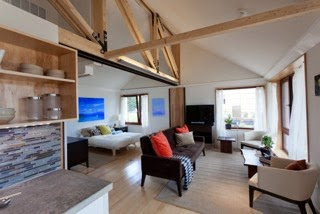Moss & Associates installed a solar-panel parking canopy at its headquarters in Fort Lauderdale
headquarters, one of the few in South Florida.
(Moss & Associates)
Building company Moss adds rare solar parking canopy
Solar parking canopy Moss & Associates
By Doreen Hemlock, Sun Sentinel
With the sun beating down on cars in parking lots across South Florida, it might seem like a no-brainer: solar-panel canopies that could shield cars from heat and also make electricity for businesses.
Construction company Moss & Associates just became one of the few to complete one locally.
Moss spent about $300,000 to build a canopy of 200 solar-panels to cover about 22 cars at the parking lot of its Fort Lauderdale headquarters. It expects to recoup that investment in about five years, thanks in part to rebates from Florida Power & Light Co. and to federal tax credits, president Scott Moss said.
Moss spent that money for several reasons: It tore down a canvas awning during a parking lot renovation, so it needed a new canopy. It could get good prices from companies that work with the builder on solar projects nationwide. And "at the end of the day, it's kind of advertising for the business we're in."
But few others have installed solar parking canopies in South Florida because of the cost, Moss said. In places with more expensive electricity like California or Hawaii, it takes less time to recoup the investment and makes more financial sense.
"Because power is so cheap from FPL, we're spoiled," Moss said. "It's easier to make the business case for solar canopies in Hawaii, where electricity is about 30 cents a kilowatt-hour," or three times the rate that FPL charges in Florida, he said.
The price for solar parking-canopies has been falling, said Clint Sockman, vice president of Advanced Green Technologies of Fort Lauderdale, the company that did the installation for Moss.
Solar panels now cost about 75 percent less than they did a decade ago. Plus, canopy designs and installation methods also have improved, slashing costs, Sockman sid.
Some companies have made the outlay, partly to show their commitment to the environment. Those include PNC Bank, which operates a branch at Davie Boulevard and Andrews Ave. in Fort Lauderdale that can generate more electricity than it uses.
FPL also has announced plans to install two 50-kilowatt solar canopies in the parking lot of the Young at Art Museum and Broward County Library in Davie.
But momentum for new projects in South Florida may well slow, Moss said. That's because FPL this year is ending its program offering rebates up to $50,000 for businesses that install solar projects. Plus, the federal tax credit on solar projects is slated to expire at the end of 2016. That will mean that the time to recoup the investment would lengthen, possibly by several years.
The Sunshine State now generates less than 1 percent of its energy from the sun. Both Moss and Advanced Green Technologies do the bulk of their solar work outside Florida.














































